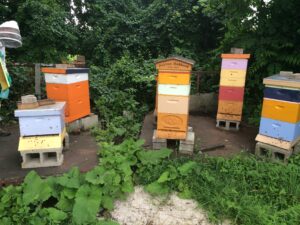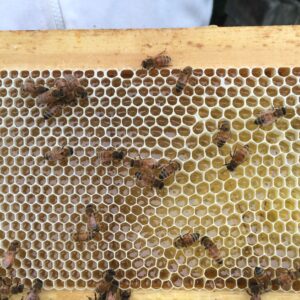The question I’m hearing most frequently these days is “how is my hive doing?” It is challenging for a newbee to know if progress is appropriate, in the dance of two billion factors that influence colony success.
Marshall and I decided to work about 20 hives this year. When we have more than that, having bees is a lot like having a job. OK, so right now we’ve got 30 … but—that’s what happens when you have Bee Disease! Like chocolate and money, you can never have too many bees. Bee Disease, while expensive, is rarely fatal. J
We’re also actively involved in about 50 colonies, what with all the hives we visit as mentors. These hives were started in April all the way through late May; some were started as nucs, others as packages. There is incredible disparity in the progress of them all—even in hives started at the same time, and in the same apiary. For example, look at the boxes in one of our apiaries. All are first year packages or nucs except the really tall one (a ’14 August swarm survivor.) We still have one struggling (front left), two that are working on what they’ll need to survive the winter, and “Dad’s hive”, center – is doing great. (And so are the weeds.)
With such disparity, benchmarks must be painted with broad strokes, but here goes …
Are you queenright? See earlier blogs for how to detect that. You need to ensure you’re queenright every time you’re in the colony—which is about every two weeks if things are going well.
By now, you’ve hopefully noticed how to read your colony’s temperament. If I open a colony and they’re generally calm, I am satisfied with finding open brood (ie, the white worms in the bottom of worker-sized cells) as evidence that I’m queenright. But, if the bees are cranky and there’s no clear reason (ie, pending thunderstorms, setting sun, or yellow jackets circling), I look further until I find eggs or the queen. Colonies are getting tall now, and invariably, Queenie is hanging out in the bottom box. I love seeing Queenie, but I don’t like disrupting the colony to go down that far if I don’t, well, need bee.
How “tall” should your colony be? (Assuming you’re in Lang equipment.) Yes, it depends on whether you have 8 or 10-frame equipment, and mediums or deeps or a combination of them, but most colonies by now should be well into their second box, with many making good progress in a third box.
If they’re still in just one deep, they’re behind—or you are! Should you have on the next box and you’ve been busy elsewhere?
If it isn’t time to add the next box yet (see previous blogs), here are some things you can do to help them:
- Is there a good reason they’re lagging? Like—they requeened (maybe even twice or more). If so, it isn’t panic time yet. Consider ways to assist, like:
- Feed them. In all this rain, many colonies have had to eat stores, not add to them. (Yes, I need to get a feeder on that maize and blue hive in the picture.)
- Supplement them. If you have multiple hives, take a frame of brood from another strong hive and add it to the weaker hive. That boost in forthcoming workforce will give the queen confidence in laying faster.
- Consider requeening—with a mated, survivor-stock queen. (Check out northernbeenetwork.org for sources.) You need a great-laying queen to get where the colony needs to be for winter.
- Combine them with a strong colony. Sure, that means you’ve “lost” a colony, but you’ve just made a stronger colony more likely to survive the winter. Google “newspaper combine” for more info.
How “tall” does your colony need to be? As I heard from an expert at the Heartland Apicultural Society meeting recently, the recommended amount of honey to leave on for a Michigan winter is 150 pounds. (It used to be 100 pounds.) When you google to determine the weight of a honey frame, you find a variety of answers—depending upon whether the frame weight is counted, the weight of the wax, etc. What we do (and what we hear from most beekeepers in this area) is go into winter with:
- Two deep boxes (8 or 10-frame) and a shallow or medium box or
- Three medium boxes
Mind you, these boxes will need to be filled with frames and bees—you can’t just pile on three boxes and think you’re ready for winter. (I’ve been mentoring a while; I’ve seen people try everything.) We typically have a great goldenrod / purple loosestrife flow in the months ahead in this area, which will help your bees fill the frames.
KEY THING about all of that is that many colonies may be making lots of honey now. (We’ve had plenty of rain!) Make sure they have room for the nectar and the queen still has room to lay. With humidity, it takes a while for nectar they’re bringing in to dry down. If you’re see dark, shiny liquid in most cells, that’s honey-to-bee. When it dries down, they’ll put a cap over it.
Should I use a queen separator? I recommend yes, but not until they’re working on a box of honey that you’ll actually harvest. As noted above, our fourth box is for human honey; the third box is going to be left for the winter. Thus, we add a queen separator above the third box. We don’t need a queen separator necessarily. Generally the queen won’t lay in the fourth box (she prefers the darker recesses of the bottom.) But, with a queen separator, we know we’re not taking the queen when we pull off that box to extract the honey.
Ventilation: Peak population, ample humidity—it is hard to cure that nectar into honey efficiently. It is even harder to efficiently access those upper boxes if you still just have a bottom entrance. Drill a hole in the top box(es). Yes, really. I know you might have lovely new equipment, but you’re going to need that hole for winter ventilation anyway, so do it. We drill half-inch holes, one, just below the hand hold of every box. They’ll love you for it.
In summary: Remember, all of this is just my opinion, and there are lots of different opinions in beekeeping. And, this just applies to places with a climate similar to SW Michigan. If you’re further north or south, or drier or wetter, your actions should be different. And finally, shoot me your questions or concerns. I LOVE mentoring; it helps me learn as well. Like a hive of bees, we all need each other.


